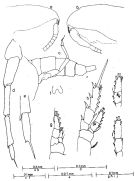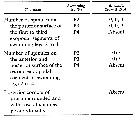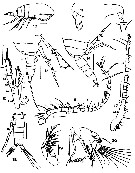|
|
 |
|
Calanoida ( Order ) |
|
|
|
Calanoidea ( Superfamily ) |
|
|
|
Paracalanidae ( Family ) |
|
|
|
Bestiolina ( Genus ) |
|
|
| |
Bestiolina similis (Sewell, 1914) (F,M) | |
| | | | | | | Syn.: | Acrocalanus similis Sewell, 1914 a (p.211, figs.F,M) ; Wellershaus, 1969 (p.253, figs.F, M); Silas, 1972 (p.646); Sreekumaran Nair & al., 1981 (p.493, fig.2cont.), Gajbhiye & al., 1991 (p.188); Gouda & Panigrahy, 1995 (p.206);
Bestiola similis : Andronov, 1972 a (p.292); Greenwood, 1976 (p.20, figs.F); Kimmerer & al., 1985 (p.426); Kimmerer & McKinnon, 1985 (p.149); Madhupratap & Haridas, 1986 (p.105, tab.1); Nishida, 1989 (p.173, table 1, 2, 3, dorsal hump); Othman & al., 1990 (p.561, 563, Table 1); McKinnon, 1991 (p.471); Ramaiah & al., 1996 (p.2); Ramaiah & Nair, 1997 (tab.1); Madhu & al., 2007 (p.54, Table 4, abundance vs monsoon);
?Bestiolina sp. Sterza & Fernades, 2006 (p.95, Table 1, occurrence, Rem.:p.103) | | | | Ref.: | | | Connell, 1981 (p.498); Bradford-Grieve, 1994 (p.51, figs.F,M); Chihara & Murano, 1997 (p.846, Pl.133: F,M); Ali, Al-Yamani & Prusova, 2007 (p.203: Tab.II, Rem.); Mercier & al., 2013 (p.760, neural ultrastructure) |  issued from : J.G. Greenwood in Proc. R. Soc. Qd, 1976, 87.
[p.21, Fig.7]. As Bestiola similis. Female (from Moreton Bay, E Australia): a, head (lateral); f, P5; g, P1; h, P2; i, endopod of P3; j, endopod of P4. Male: b, head (lateral); c, posterior metasomal border with P5 in situ and urosome (lateral left side); d, P5; e, terminal region of P5. Nota: Tis species differs from B. inermis in absence of spine-rows on posterior exopodal segments 1 and 2 of P2 to P4; absence of spinules on 5th thoracic segment,; smaller size and having longer rostral filaments.
.
|
 Issued from : R.B.S. Sewell in Spolia Zeylanica, 1914, 9. [Pl.XVII, Figs.3-5]. As Acrocalanus similis. Female (from Gulf of Mannar): 3, P3; 4, P4. Male: 5, P5.
|
 issued from : S.Y. Moon, W. Lee & H.Y. Soh in Proc. Biol. Soc. Washington, 2010, 123 (1). [p.44, Table 1]. Presence and number of spinules on the anterior surface of the exopods and endopods of swimming legs 2 - 4 from (Sewell, 1914). These characteristics were taken from Ali & al. (2007).
|
 Issued from : S. Wellershaus in Veröff. Inst. Meeresforsch. Bremerh., 1969, 11 (2). [p.252, Figs.10-20]. As Acrocalanus similis. Female (from Cochin Backwater, S. India): 10, habitus (lateral; spot on 5th thoracic segment indicates red pigmentation); 11, forehead (lateral); 13, last thoracic segments and urosome (lateral right side); 15, left P4 and P5 (anterior); 16, A1; 19, Mxp; 20, Md. Male: 12, forehead (anterior and lateral); 14, 3th to 5th thoracic segments and urosome (lateral right side); 17, A1; 18, urosome (dorsal; somewhat crushed). Scale : single line = 0.1 mm ; double line = 0.05 mm. Nota female: - Ratio thorax : abdomen = 3.3-3.5 (for 7 animals). - A1 reaches the caudal rami (or is even longer); segments 1-2 to 7 without spinules. - P5 rudimentary. Nota male: Ratio thorax : abdomen = 2.5-2.6; - Head of many males bears a transparent swelling above A2. - A1 symmetrical. Remarks: Some animals bear a red patch in thoracic segment 5.
|
 Issued from : S. Wellershaus in Veröff. Inst. Meeresforsch. Bremerh., 1969, 11 (2). [p.253]. As Acrocalanus similis. Proportions of the abdominal segments in female (for 7 animals) and male (for 2 animals).
| | | | | Compl. Ref.: | | | Ohtsuka & al., 1995 (p.159); McKinnon & Klumpp, 1998 (tab.1); Lenz & al., 2000 (p.338); McKinnon & Duggan, 2001 (p.121); Ueda, 2001 (p.96, occurrence); Greenwood & al., 2002 (p.17, Table 2); Rezai & al., 2004 (p.486, tab.2, 3, abundance, Rem.); Rezai & al., 2005 (p.157, Table 2: spatial & temporal variations); McKinnon & al., 2008 (p.844: Tab.1, fig.7); VanderLugt & Lenz, 2008 (p.69, production); C.-Y. Lee & al., 2009 (p.151, Tab.2); Ohtsuka & al., 2008 (p.115, Table 5); Camus & al., 2009 (p.189, feeding); Gusmao & McKinnon, 2009 (p.1101, Table I, sex ratios); Fazeli & al., 2010 (p.153, Table 1, as Bestiulina similis); Maiphae & Sa-ardrit, 2011 (p.641, Table 2, 3, as similes); Saitoh & al., 2011 (p.85, Table 4, 5); Chew & Chong, 2011 (p.127, fig.4, 5, Table 2, 3, abundance vs location); Johan & al., 2012 (p.647, Table 1, fig.2, salinity range); Johan & al., 2012 (2013) (p.1, Table 1); Gusmao & al., 2013 (p.279, Table 7, sex ratio); Cornils & Blanco-Bercial, 2013 (p.861, Table 1, molecular analysis, figs.3, 4, 5); Jungbluth & Lenz, 2013 (p.630, Table I); Nakajima & al., 2015 (p.19, Table 3: abundance); Araujo & al., 2016 (p.1, Table 3, 5, abundance, %, Rem.: p.7); Buskey & al., 2017 (p.754, myelinate fiber vs escape response); Ohtsuka & Nishida, 2017 (p.565, Table 22.1) | | | | NZ: | 6 | | |
|
Distribution map of Bestiolina similis by geographical zones
|
| | | | | | | | | | Loc: | | | South Africa (SE), Indian Ocean, Gulf of Oman, Arabian Sea, Oman Sea, Bombay, Cochin, G. of Mannar, Burhabalanga estuary, Rushikulya estuary, Kerala, G. of Bengal, Burma, Perai River estuary (Penang), Straits of Malacca, Sangga estuary (mainly lower estuary and off shore), G. of Thailand, Malaysia (Sarawak: (Bintulu coast), Tioman Is., NW Taiwan (rare), Okinawa Island: Lagoon, Palau Is., Australia (G. of Carpentaria, North West Cape, Darwin Harbour, Shark Bay, Melbourne, Great Barrier Reef, Brisbane River estuary, Moreton Bay, Haughton River, Mouth of Ross River), N Pacif. (Hawaii, Kaneohe Bay), Brazil (Macaé, Vitoria Bay estuary, Sao Joao, Perequê-Açu, Bracui)
Data from: Cornils & Blanco-Bercial (2013): 21°26'N; 157°47'W. | | | | N: | 44 | | | | Lg.: | | | (82) F: 0,8-0,75; M: 0,8; (172) F: 0,72-0,81; M: 0,79-0,81; (196) F: 0,81-0,72; M: 0,8; (866) F: 0,7-1; M: 0,7-0,9; {F: 0,70-1,00; M: 0,70-0,90} | | | | Rem.: | estuary, coastal. Salinity range: 7.9 to 32.9 p.1000.
Sewell (1929, p 81) considers this species as a synonym of Acrocalanus inermis (= Bestiolina inermis), but he is not followed by Wellershaus (1969) and Greenwood (1976) who underline the differences.
The species shows the following peculiarities according to Sewell (1914); 1- Total body length smaller than inermis. 2- A1: terminal segment is prolonged; no transverse rows of spinules on A1-2 to 7. 3- no spinules on thr 5th thoracic segment; 4- no spines on the posterior aspect of exopodal segment 2 of P2-P4; 5- Rostral filaments long and slender. For Welleshaus, since in spite of the distance between the sites of Cochin and Mannar, the animals are very similar, and variability within one population is very little to consider A. simiulis an independant taxon.
Its occurrence reported for Brazil (Macaé, São João, Perequê-Açu, Bracuí) by Araujo et al., 2016 (p. 1, Tables 3 and 5, abundance, %, Remarks: p. 7), was later reviewed, and it was verified that the specimens actually belong to the species Bestiolina brasiliensis. Only the occurrence for the Vitória Bay estuary should be maintained, as that material was not reviewed. (Thanks to Dra. Cristina de Oliveira Dias for this note) | | | Last update : 22/10/2025 | |
|
|
 Any use of this site for a publication will be mentioned with the following reference : Any use of this site for a publication will be mentioned with the following reference :
Razouls C., Desreumaux N., Kouwenberg J. and de Bovée F., 2005-2025. - Biodiversity of Marine Planktonic Copepods (morphology, geographical distribution and biological data). Sorbonne University, CNRS. Available at http://copepodes.obs-banyuls.fr/en [Accessed January 05, 2026] © copyright 2005-2025 Sorbonne University, CNRS
|
|
 |
 |







